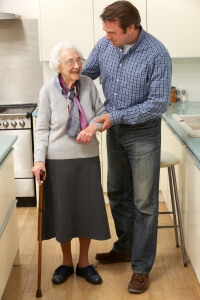Some slippers aren’t all they’re cracked up to be
After working many years as a foot care nurse, I have observed a perennial problem: the drying out of the soles of many clients’ feet. If left unchecked, bothersome and unsightly calluses and cracks can develop. Cracks that form, usually on the heels, can become painful and may lead to an infection. This can be especially problematic for diabetics and will require medical treatment.
Having puzzled over why this happens, I began to survey my clients. I now believe that the tendency to wear loose-fitting slippers indoors for part or most of the day causes the dryness. Unfortunately, the soles of the feet are more difficult to see as we age, so the owner doesn’t always realize just how dry they may be. One way to check the soles is to place a mirror on the floor and hold the foot above it or to ask a willing friend or family member to have a look for you.
![]() Slippers are convenient, “comfy,” cheap, and easy to “slip” on and off. We don’t have to bend over to put them on and can even throw them in the washing machine. Many people become attached to wearing their slippers all day.
Slippers are convenient, “comfy,” cheap, and easy to “slip” on and off. We don’t have to bend over to put them on and can even throw them in the washing machine. Many people become attached to wearing their slippers all day.
Not your grandmother’s slippers
Once upon a time, slippers, if we think back two or three decades, were relegated to the bedroom, to sit by the bed and be worn on the nightly or early morning trips to the bathroom. Slippers were usually matched with a bathrobe, and they lived close by each other.
Back then, having slippers on all day signaled that you were either sick or, perhaps, taking some downtime. Somehow, maybe because we like easy and convenient things too much, slippers found their way into daily use in other areas of the house. These days in many homes, they can be found sitting by the front door ready to “slip” on the feet upon the arrival of the wearer.
Careful not to slipper and fall
Like many things in life, easy doesn’t always mean it’s good for you. The cause of the dryness is friction, which occurs as the bottom of the loose slipper shifts back and forth, over and over, rubbing against the sole of the wearer’s foot when walking. This gradual and repetitive frictional force generates heat on the skin, forcing moisture out, resulting in a build-up of dry skin, callouses, and, potentially, cracks. During the winter when more time is spent indoors, the dry soles become more evident, but can persist during other seasons.
There are other ways to dry out the soles besides wearing loose slippers, such as walking with only socks on the feet, wearing shoes or sandals that are open in the back making the heel unstable, or by walking barefoot on carpeting. All cause friction on the soles of the feet. Wearing loose slippers can also have a negative effect on the way one walks. Seniors with loose slippers on their feet can develop an improper gait – essentially a shuffle. This instability or unsteadiness becomes a safety issue that could lead to an increase in falls and injuries. Occupational and physical therapists caution their patients about wearing footwear that slips off or can easily get caught on things when walking.
Footloose and fancy feet
Besides avoiding dry, callused feet and unwanted falls, seniors are also likely to be active for longer periods when wearing good shoes rather than slippers. I haven’t yet seen a study on the use of slippers versus shoes, but after talking with many seniors over many years, I’m convinced that the actual benefits of wearing comfortable, well-fitting shoes throughout the day surpass any perceived benefits of slipper use. When it becomes difficult to bend over, velcro shoes are available to make life a little easier. Another option is supportive, slip-on shoes with elastic laces, which, combined with a long-handled shoehorn, can make it easier to get shoes on.
As we age, our joints crave support while we walk about on hard, flat surfaces, whether indoors or outdoors. Unsupportive footwear causes not just our joints but our whole bodies to tire more easily, thus reducing how far we can walk and how long we can spend being active. Becoming more active is the result of wearing good-fitting, comfortable shoes that provide support and stability. In short, prevention is always the best medicine. Wearing good-fitting, comfortable shoes that provide support and stability can help our feet work for us. After all, we want our feet to be able to continue carrying us around for as long as possible.





